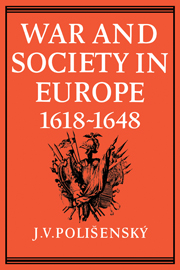Book contents
- Frontmatter
- Contents
- Preface
- Map of Czechoslovakia with list of locations of archives and libraries
- Introduction
- PART ONE PROBLEMS IN THE HISTORY OF THE THIRTY YEARS' WAR
- 1 Attempts at a reinterpretation of the conflict
- 2 The Bohemian War 1618–20
- 3 The Dutch period of the conflict 1621–5
- 4 The Danish intervention and the attempts at the formation of a grand coalition
- 5 The Swedish-Dutch period of the conflict 1630–5
- 6 The Swedish-French period 1635–43
- 7 War, revolution, peace negotiations 1643–50
- PART TWO THE EFFECTS OF THE THIRTY YEARS' WAR
- Conclusion
- Notes
- Appendix Tabular survey of archives, libraries and individual collections
- Index
1 - Attempts at a reinterpretation of the conflict
Published online by Cambridge University Press: 05 April 2012
- Frontmatter
- Contents
- Preface
- Map of Czechoslovakia with list of locations of archives and libraries
- Introduction
- PART ONE PROBLEMS IN THE HISTORY OF THE THIRTY YEARS' WAR
- 1 Attempts at a reinterpretation of the conflict
- 2 The Bohemian War 1618–20
- 3 The Dutch period of the conflict 1621–5
- 4 The Danish intervention and the attempts at the formation of a grand coalition
- 5 The Swedish-Dutch period of the conflict 1630–5
- 6 The Swedish-French period 1635–43
- 7 War, revolution, peace negotiations 1643–50
- PART TWO THE EFFECTS OF THE THIRTY YEARS' WAR
- Conclusion
- Notes
- Appendix Tabular survey of archives, libraries and individual collections
- Index
Summary
PROBLEMS AND SOURCES FOR THE HISTORY OF THE THIRTY YEARS' WAR
Of the older work appearing in the 1930s, most of it in the years immediately preceding the Second World War, the books by the German Günther Franz, the Frenchmen Georges Pagès and V. L. Tapié, and the Soviet historian O. L. Veinstein and the popular English book by C. V. Wedgwood are still useful.
The Soviet historian V. M. Alekseyev has written a book on the Thirty Years' War intended for a wide audience, based chiefly on the findings of Soviet historical scholarship. The author of another attempt at a ‘new explanation’ of the conflict, S. H. Steinberg, tried to explore its origins on a very wide basis. Thus he took account of work by east European, including Czechoslovak, historians. Apparently in reaction against the thesis, pressed by the Nazis, of the catastrophic results of the War and the possibility of its repetition, Steinberg underestimated the concrete consequences of the conflict and even doubts the validity of the concept of a ‘Thirty Years’ War'. This is how the phrase appears – in quotation marks – in the English version; they are absent in the German edition, apparently in deference to his German readers.
Steinberg's conclusions are disputed by Theodore K. Rabb in his sober study of the results of the Thirty Years' War on the German economy, which was published in 1962.
- Type
- Chapter
- Information
- War and Society in Europe 1618–1648 , pp. 17 - 35Publisher: Cambridge University PressPrint publication year: 1978



